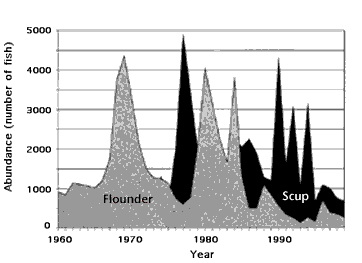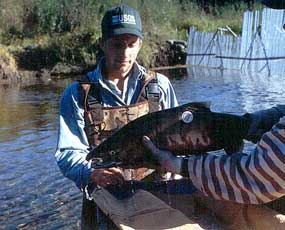2. How do we investigate the Pelagic Community?
There are various methods used to investigate the pelagic community. Different procedures are used depending upon what organisms are being examined. When trying to examine the population and species of fish in an area, scientists often turn to the fisheries. Fisheries keep track of the species caught and the frequency of catching these fish. This gives us a rough approximation of the fish population.
 |
| Annual abundance of Winter Flounder (light area) and Scup (dark area) from fish trawls taken in Narragansett Bay from 1960 to 2000. From Maritimes, winter 2000 issue |
The main way to investigate the pelagic community is using sampling nets. Nets are towed through the water by boats that collect samples of marine organisms. After the net is brought back onboard, the species are identified and counts are made of the numbers of individuals of each species. This method provides a good estimate of relative abundance for organisms that live on or just above the seafloor, however fast swimming fish can avoid the nets.
Pelagic organisms can also be investigated using mark/recapture methods. Fish that are either grown in the laboratory or caught in the wild are measured and information such as length, weight, and age are recorded. They are then marked with an identification tag and released into the estuary. These fish may be recaptured, by commercial and recreational fishermen or scientists, and re-measured. Researchers can learn about their life history such as how quickly they grow and their distribution in the estuary.

A disk tag under the dorsal fin is used to identify this salmon
(Courtesy of US Geological Survey)
Pelagic species change abundance with seasons and time of day. During colder seasons many species of fish migrate to warmer waters. During nighttime, many of the bottom dwelling species rise into the water column and swim within the pelagic community. Several organisms are drawn to bright lights and may be collected from a boat or pier at night with a bright light. All of these collection methods, however, have sampling errors and are not entirely accurate.
| 


